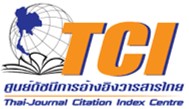Numerical evaluation of an external environment effectiveness to the surface plasmon mode in Au slot waveguide for design the sensor simulation
DOI:
https://doi.org/10.55674/jmsae.v12i2.249088Keywords:
Array waveguide grating, Nanograting, Plasmonic sensor, PolaritonAbstract
The effective permittivity of gold thin films with an external thin dielectric layer on the top and core of the slot waveguide was evaluated as an effective compound semi-metal layer of the surface plasmonic polariton slot waveguide that will vary due to some environmental factors. By uses simple parallel and series permittivity of compound material, this value need for the computation of the effective propagating vector βsp. This takes for a sensor model designing which the external environment effectiveness was changed by the surface plasmonic mode in its slot waveguide. So the resonance length and grating period are evaluated for the sensor model in the first. Further, the propagation of the SPP surface wave mode along the interface between the compound cladding and Si dielectric waveguide is computed, while the effective refractive index of the compound cladding of the slot waveguide is increased from 1 − 1.50. The computation results showed that the TM0 mode power transfer and propagation length seem to vary with this effective refractive index of the compound cladding on the surface plasmonic polariton waveguide. The 140 nm gap width and 3.70 mm long waveguide is also simulated by the finite different time domain method in the optiwave program, where the TM0 mode transition output is corrected, while the refractive index of the environment layer is changed. The results of the simulation showed good agreement with the computation in that the TM0 mode depends on the external refractive of index and input wavelength. This result shows that loss peak ships vary with the external refractive index thin film layer and input wavelength. Thus, they seem to be useful for sensor applications such as the solution concentration analytic.
References
N.T. Huong, N.V. Chinh, C.M. Hoang, Wedge Surface Plasmon Polariton Waveguides Based on Wet-Bulk Micromachining, Photonics. 6(1) (2019) 21.
P. N. Melentiev, A. Kalmykov, A. Kuzin, D. Negrov, V. Klimov, V. I. Balykin, Open-Type SPP Waveguide with Ultrahigh Bandwidth up to 3.5 THz, Photonics. 6 (2019) 1425.
S. Kumari, S. Gupta, Performance Estimation of Hybrid Plasmonic Waveguide in Presence of Stress. Plasmonics. 16(2021) 359.
A. M. Shrivastav, U. Cvelbar, I. Abdulhalim, A comprehensive review on plasmonic-based biosensors used in viral diagnostics, Communications Biology) 4(70) (2021) 1.
A. Andryieuski, A.V. Zenin, R. Malureanu, S. V.Volkov, I. S. Bozhevolnyi, V.A. Lavrinenko, Direct Characterization of Plasmonic Slot Waveguides and Nano couplers, Nano Letters. 14 (2014) 3925.
J.R .Salgueiro, Y.S. Kivshar, Nonlinear couplers with tapered plasmonic waveguides. Optics Express. 20 (2012) 9403.
Y. Fu, X. Hu, C. Lu, S. Yue, H. Yang, G. Qihuang, All Optical Logic Gates Based on Nanoscale Plasmonic Slot Waveguides, Nano Letters. 12 (2012) 5784.
V.A. Zenin, V.S. V., Z. Han, S. L .Bozhevolnyi, E. Devaux, T.W. Ebbesen, Directional coupling in channel plasmon polariton waveguides, Optics Express. 20 (2012) 6124.
C., S. Li, H. Sun, Metamaterials Application in Sensing, Sensors. 12(2012) 2742.
Y. Chen, H. Ming, Review of Surface Plasmon Resonance and Localized Surface Plasmon Resonance Sensor, Photonic Sensors. 2 (2012) 37.
T. Wang, C. Tu, F. Liu, H. Chen, Surface Plasmon Resonance Waveguide Biosensor by Bipolarization Wavelength Interrogation, IEEE Photonics Technology Letters. 16 (2004) 1715.
G. D. Osowiecki, E. B., A. Naqavi, H. P. Herzig, Vertically Coupled Plasmonic Slot Waveguide Cavity for Localized Bio-sensing applications, Optics Express. 22 (2014) 20871.
Z. Han, A. Y. Elezzabi, V. Van, Wideband Y-splitter and aperture-assisted coupler based on sub-diffraction confined plasmonic slot waveguides, Applied Physics Letters. 96 (2010) 131106-1.
C. Delacour, S. Blaize, P. Grosse, J. M. Fedeli, A. l. Bruyant, R. Salas-Montiel, G. Lerondel, A. Chelnokov, Efficient Directional Coupling between Silicon and Copper Plasmonic Nano slot Waveguides: toward Metal-Oxide-Silicon Nanophotonics, Nano Letters. 10(2000) 2922.
Z. Zhu, C. E. Garcia-Ortiz, Z. Han, I. P. Radko, S. I Bozhevolnyi, Compact and Broadband Directional Coupling and Demultiplexing in Dielectric-loaded Surface Plasmon Polariton Waveguides Based on the Multimode Interference Effect, Applied Physics Letters. 103 (2013) 061108-1.
C. Du, Y. Chiou, Vertical Directional Couplers with Ultra-Short Coupling Length Based on Hybrid Plasmonic Waveguides, Journal of Lightwave Technology. 32 (2014) 2065.

Downloads
Published
How to Cite
Issue
Section
License
Copyright (c) 2023 Journal of Materials Science and Applied Energy

This work is licensed under a Creative Commons Attribution-NonCommercial-NoDerivatives 4.0 International License.







